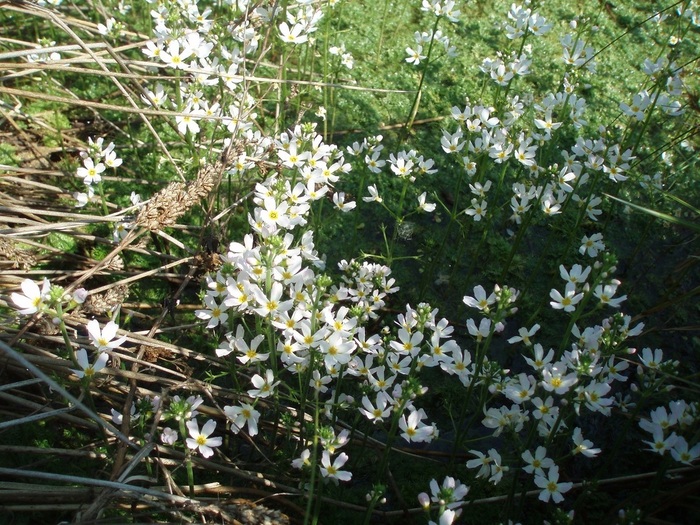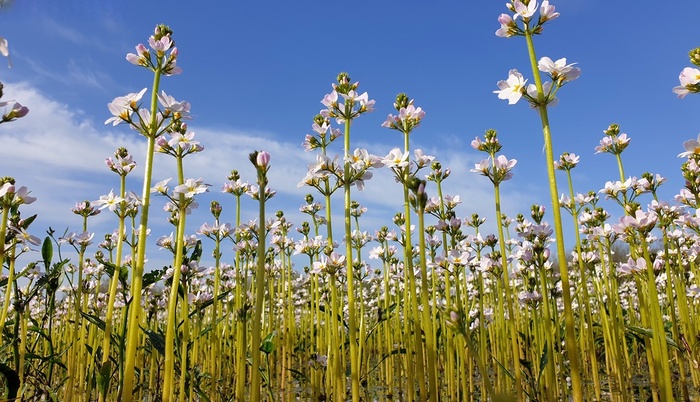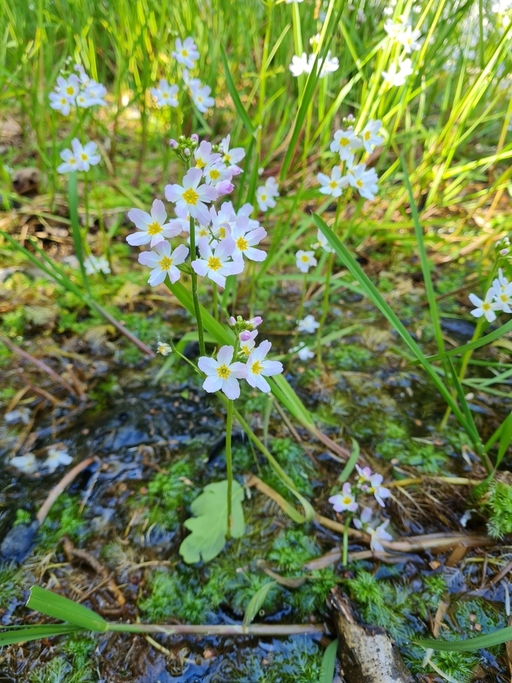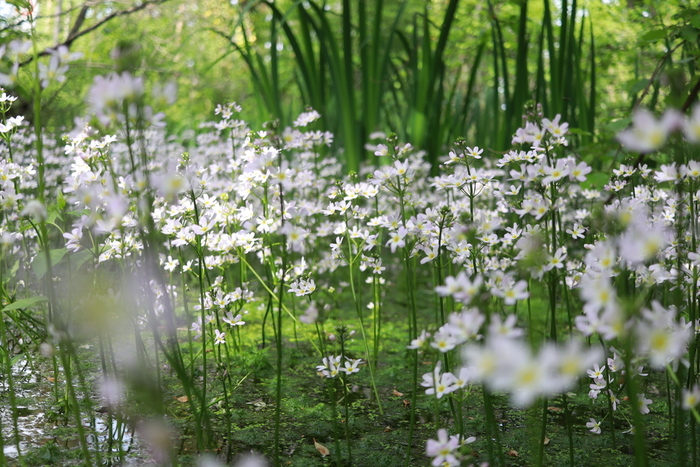Hottonia palustris, commonly known as the water violet or featherfoil, is a captivating aquatic plant that thrives in the wetlands and marshes of temperate regions across Europe and parts of Asia. This perennial plant, renowned for its delicate, feathery flowers and submerged growth, plays a pivotal role in aquatic ecosystems, offering both ecological and ornamental value. In this article, we explore the key characteristics, habitat, ecological significance, propagation, and cultivation of Hottonia palustris, alongside its uses in landscape design and wetland restoration projects.

Hottonia palustris belongs to the family Primulaceae and is native to shallow freshwater habitats such as ponds, ditches, and marshes. It is characterized by its finely divided, feathery leaves that float on the water’s surface, creating a striking visual effect. The plant’s name, “featherfoil,” refers to its soft, feathery appearance, which contrasts beautifully with the bright, violet flowers that bloom above the water.
Commonly referred to as the "water violet," this plant’s striking aesthetic has made it a favored choice for water gardens and naturalistic landscaping. Its ability to grow in submerged conditions makes it an ideal choice for pond enthusiasts and ecologists alike.

Hottonia palustris typically reaches a height of 20 to 40 centimeters (8-16 inches) when grown in aquatic environments, although it may grow taller under optimal conditions. The plant’s leaves are finely divided, resembling feathers, and are primarily located at the water's surface. These leaves can vary in size, but their characteristic feathery structure is the plant's most defining trait.
The flowers of Hottonia palustris bloom in clusters above the water and display a striking violet or pale purple hue. Each flower is tubular, with five petals arranged in a star-like formation. Flowering occurs in late spring to early summer, and the blooms are highly attractive to pollinating insects, especially bees. The plant’s flowers are often solitary and rise on long, slender stalks from the submerged foliage.
Water violets are typically found in freshwater environments, including ponds, lakes, ditches, and marshes. They thrive in shallow, stagnant waters with low to moderate nutrient levels and prefer slightly acidic to neutral water conditions. As a submerged plant, Hottonia palustris serves several vital ecological functions:
Water Purification: By absorbing excess nutrients, particularly nitrogen and phosphorus, Hottonia palustris helps maintain water quality, reducing eutrophication risks in freshwater ecosystems.
Habitat for Aquatic Life: The feathery leaves of Hottonia palustris provide a refuge for small aquatic creatures, including insect larvae and tiny crustaceans. These organisms, in turn, support the local food web.
Erosion Control: As a submerged plant, Hottonia palustris helps stabilize sediments in shallow waters, reducing erosion along the water's edge. This makes it an invaluable species for aquatic habitat restoration.
Pollination: The bright, violet flowers attract a range of pollinators, including bees and butterflies, further enhancing biodiversity in the surrounding ecosystem.

Hottonia palustris can be propagated through seeds or vegetative means. The plant’s seeds are typically dispersed by water currents, and they can germinate in suitable, nutrient-rich substrates. However, to successfully cultivate Hottonia palustris in a garden pond or aquatic landscape, it’s important to consider the following steps:
Growing Conditions: Hottonia palustris prefers shallow, slow-moving water that is rich in organic matter. It can be planted in either pots or directly in the soil of a pond's bottom. Ensure the plant receives partial sunlight and is submerged at a depth of 10 to 30 centimeters (4-12 inches).
Water Quality: This plant thrives in slightly acidic to neutral water with a pH level between 6.0 and 7.5. It prefers clear water with low to moderate nutrient levels and does best in waters that are not subject to strong currents or wave action.
Light Requirements: While Hottonia palustris does well in full or partial sunlight, excessive direct sunlight may lead to algae growth and hinder its growth. Proper shading or positioning in a pond will optimize its health and flowering potential.
Winter Care: In colder climates, Hottonia palustris may die back during winter but will regenerate in the spring from its root system. In more temperate zones, the plant is hardy and can survive the colder months with appropriate care.
Due to its aesthetic appeal and ecological benefits, Hottonia palustris is frequently used in ornamental water gardens, wildlife ponds, and wetland restoration projects. Its delicate flowers and graceful foliage make it an excellent choice for creating naturalistic water features.

In wetland restoration projects, Hottonia palustris is valued for its role in improving water quality and stabilizing the aquatic environment. Its ability to enhance the ecological integrity of ponds and marshes makes it an indispensable species in habitat restoration, particularly in areas that are undergoing ecological degradation due to nutrient pollution or habitat loss.
Although Hottonia palustris is not listed as endangered, its populations in certain regions are threatened by habitat destruction, particularly from urban development and water pollution. The loss of wetland habitats, coupled with the introduction of invasive species, poses a risk to the long-term viability of this plant in some areas.
Efforts to conserve aquatic plants like Hottonia palustris focus on protecting wetland habitats and ensuring that water quality is maintained through sustainable land-use practices. Restoration efforts often involve reintroducing native species such as water violets to degraded ecosystems to enhance biodiversity and restore ecological balance.
Hottonia palustris, or water violet, is a remarkable aquatic plant with both ecological and ornamental value. Its delicate feathery foliage, striking violet flowers, and role in maintaining healthy aquatic ecosystems make it a valuable species in the natural world and in garden landscapes. Whether used in ornamental ponds, wetland restoration projects, or as a pollinator-friendly plant, Hottonia palustris continues to captivate gardeners and ecologists alike. By understanding its habitat requirements and ecological importance, we can better appreciate and preserve this exquisite aquatic plant for generations to come.
Hottonia palustris (Water Violet). (n.d.). Royal Horticultural Society. Retrieved from RHS.org
Pollard, E. (2019). The Role of Aquatic Plants in Ecosystem Restoration. Wetlands International Journal, 45(3), 154-161.
Black, S., & McGregor, A. (2020). Wetland Plant Ecology: The Case of Hottonia palustris. Ecology and Conservation, 56(1), 78-83.
animal tags: Primulaceae
We created this article in conjunction with AI technology, then made sure it was fact-checked and edited by a Animals Top editor.